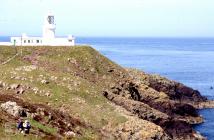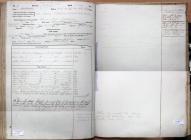Gellir lawrlwytho cynnwys at ddefnydd anfasnachol, megis defnydd personol neu ar gyfer adnoddau addysgol.
Ar gyfer defnydd masnachol cysyllwch yn uniongyrchol gyda deilydd yr hawlfraint os gwelwch yn dda.
Read more about the The Creative Archive Licence.
Disgrifiad
The SWANSEA TRADER was a wooden smack built at Bideford in 1828. It became one of the shipping losses during the Royal Charter gale, 25-26 October 1859.
The term 'smack' is a 19th century word used to describe a form of traditional fishing boat. These vessels were also used to deliver a wide variety of cargoes to coastal villages, including sand, gravel, limestone, slate, potatoes, herring, coal and bricks.
The inclusion of 'Swansea' in the smack's name together with the place of build being Bideford suggests that our smack spent the early part of its working life plying between south Wales and Devon. If you pass the mouse over this image of the SWANSEA TRADER's register entry, you will find information about the people associated vessel as well a technical description:
Official number 15585. 1 deck, 1 mast, smack rigged, square stern, carvel built, framework wood. Length from the forepart of the stem under the Bowsprit to the aft side of the Head of the sternpost 45.5ft. Main breadth to outside of plank 15.5ft. Depth in hold from tonnage deck to ceiling at midships 8.3ft.Gross tonnage 55.51.
The smack was transferred to the port of Aberystwyth on 29 August 1859 after it was sold to David Jenkins of Borth by Thomas Cook of Swansea. The smack was carrying a cargo of roofing slate when it was driven ashore and wrecked on Dinas Head.
Sources include:
Davies, T, 2009, Borth: A Maritime History, pg26
Lloyds Register of British and Foreign Shipping, 1 July 1859 - 30 June 1860, number 835 in S
Mercantile Navy List 1858, pg302 (online source Google Books)
Port of Aberystwyth Shipping Register 1855-1862, Ceredigion Archive Service A/SHIP/5, folio 126
The SWANSEA TRADER had loaded a heavy cargo of slate somewhere on the Welsh coast? Which are ports and harbours are most associated with the Welsh slate trade?
For many centuries, the prosperity of the mariners of Borth was based on fishing. Can you find out which species of fish they were primarily catching? And why trawl nets (i.e. nets dragged across the seabed) would not be used to catch them?
By which number would you have to multiply the length, breadth and depth in hold measurements to convert them to metres? How many of people of your height would have been able to lie on the deck of the SWANSEA TRADER head to toe?






Oes gennych chi wybodaeth ychwanegol am yr eitem hon? Gadewch sylwad isod
Sylwadau (0)
Rhaid mewngofnodi i bostio sylw